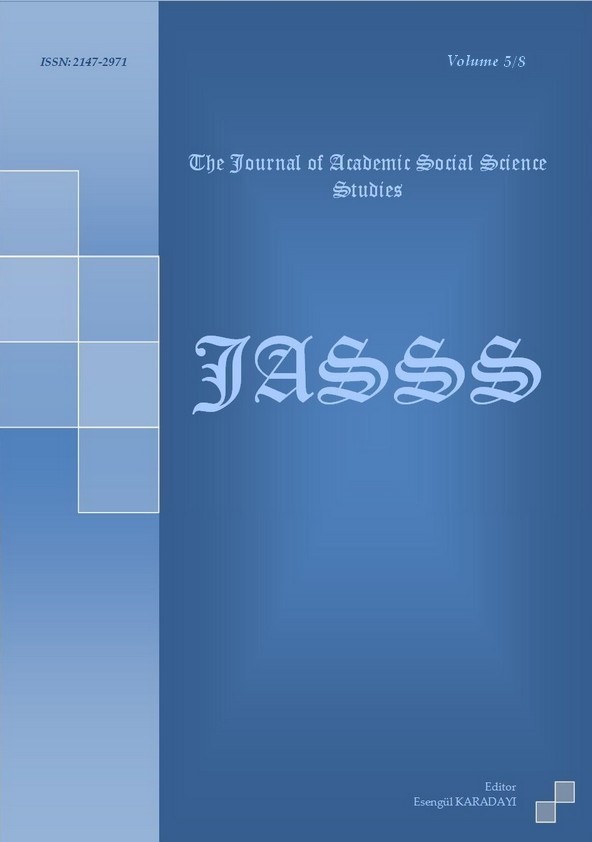Author :
Abstract
Bu çalışmanın amacı, üniversite birinci sınıf öğrencilerinin Probleme Dayalı Öğrenme (PDÖ) ortamı hakkındaki görüşlerini geçerli ve güvenilir bir ölçek yardımıyla ortaya çıkarmaktır. Çalışma, Deneysel Araştırmalardan, Deneme Öncesi Desenlerden Tek Grup Son Test Modeli kullanılarak yürütülmüştür. Araştırma bulguları, nicel ve nitel yaklaşımlarla elde edilmiştir. Araştırmanın örneklemini, Bartın Üniversitesi, Eğitim Fakültesi, İlköğretim Bölümü, Sınıf Öğretmenliği ve Fen Bilgisi Öğretmenliği programlarında öğrenim gören ve Genel Kimya/Genel Kimya-II dersini alan, toplam 70 birinci sınıf öğrencisi oluşturmaktadır. Uygulama, 2011-2012 öğretim yılı bahar döneminde 20 ders saati süreyle gerçekleştirilmiştir. Nicel veriler; “Probleme Dayalı Öğrenme Ortamı Envanteri” ile toplanmıştır. Nitel veriler ise “PDÖ Yöntemi Hakkındaki Öğrenci Görüşleri Anketi” ile elde edilmiştir. Nicel verilerin analizinde one sample t-testinden ve yüzde ve frekans çizelgeleri içeren betimsel istatistiklerden faydalanılırken nitel veriler ise betimsel analize tabi tutulmuştur. Araştırmanın bulguları envanterde yer alan öğretmen desteği, öğrenci sorumluluğu, öğrenci etkileşimi ve işbirliği ve problemin kalitesi alt boyutlarının Sınıf Öğretmenliği (SNÖ) ve Fen Bilgisi Öğretmenliği (FBÖ) lisans programı birinci sınıf öğrencileri nazarında değerlendirilmesi sonucunda, SNÖ’de problemin kalitesi alt boyutu dışındaki diğer alt boyutların ortalamasının ve FBÖ’de tüm alt boyutların ortalamasının ortalama değerden istatistikî olarak anlamlı olduğunu göstermektedir. Betimsel istatistikten elde edilen verilerden ise, PDÖ ortamından SNÖ öğrencilerin FBÖ öğrencilerine göre problemin kalitesi alt boyutunun dışındaki tüm alt boyutlarda yer alan ifadelerden çok daha fazla memnun kaldıkları anlaşılmaktadır.
Keywords
Abstract
The aim of this study was to explore undergraduate students’ perceptions about the Problem-Based Learning Environment (PBLE) through a reliable and valid scale. One group post-test design, which is a pre-experimental research design, was used in the study. Both quantitative and qualitative techniques were used as data collecting tools. The sample of the study was constituted from 70 freshmen who took General Chemistry/General Chemistry-II courses in two separate teacher education programs, which are the Class Teacher Education Program (CTEP) and the Science Teacher Education Program (STEP). The implementation took twenty class hours. While quantitative data were collected through a PBLE scale, qualitative data were collected through a questionnaire of determining students’ views about PBL practices. Quantitative data were analyzed by one sample t-test, and qualitative data were processed with descriptive analysis and presented in tables. As a result of assessing the sub-scales of the PBLE scale from the eyes of the students, it was found that the averages of all sub-scales except one, the problem quality, in CTEP and the averages of all sub-scales in the STEP were statistically significant. Also, it was understood that CTEP students were gladder with all other sub-scaless except one than the STEP students.
Keywords
- BRİDGES, E.M. & HALLİNGER, P. (1995). Implementing problem-based learning in leadership development. Cushing- Malloy, Inc., 211 p, Ann Arbor, Michigan.
- BÜYÜKÖZTÜRK, Ş. (2003). Sosyal bilimler için veri analizi el kitabı. 3. Baskı, Pegem A Yayıncılık, 195 s, Ankara, Türkiye.
- DODS, R. F. (1996). A problem-based learning design for teaching biochemistry. Journal of Chemical Education, 73, 225–228.
- DUCH, B. J. (2001). Writing problems for deeper understanding. The power of problem-based learning, Ed: Duch, B.J., Groh, S.E. and Allen, D.E., Stylus Publishing, LLC, Sterling, Virginia, 47-53.
- GALLAGHER, S. A., STEPIEN, W. J., SHER, B. T. & WORKMAN, D. (1995). Implementing problem-based learning in science classrooms. School Science and Mathematics, 95(3), 136–146.
- GİJBELS, D., WATERİNG, G.V.D., and DOCHY, F., (2005). Integrating assesment tasks in a problem based learning environment. Assesment Evaluation in Higher Education, 30 (1), 73-86.
- GREENWALD, N. L. (2000). Learning from problems. The Science Teacher, 67 (4), 28- 32.
- GROH, S. E. (2001). Using problem-based learning in general chemistry. In Duch, B. J, Groh, S. E., & Allen, D. E. (Eds.), A practical “how to ” for teaching undergraduate courses in any discipline: The power of problem-based learning (pp. 121-131). Sterling, VA: Stylus Publishing.
- HOLEN, A., (2000). The PBL group: self-reflections and feedback for improved learning and growth. Medical Teacher, 22 (5), 485-488.
- HUGHES, K. D. (1993). Marine microcosm using an aquarium to teach undergraduate analytical chemistry. Analytical Chemistry, 65, 883–889.
- JOHNSON, B. & CHRİSTENSEN, L. (2004). Educational research: quantitative, qualitative and mixed approaches. Pearson Education, Inc., Second Edition, 562 p, Boston.
- RAM, P. (1999). Problem-based learning in undergraduate education. A sophomore chemistry laboratory. Journal of Chemical Education, 76, 1122-1126
- SAVİN-BADEN, M. and MAJOR, C.H., (2004). Foundation of problem-based learning. society for research into higher education. Open University Press, 197 p, UK.
- ŞENOCAK, E., (2009). Development of an instrument for assessing undergraduate science students’ perceptions: the problem-based learning environment inventory. J Sci Educ Technol, 18, 560-569.
- UDEN, L. and BEAUMONT, C., (2006). Techonology and problem-based learning. Information Science Publishing, 344 p, London, UK.
- WENZEL, T. J. (1995). A new approach to undergraduate analytical chemistry. Analytical Chemistry, 67, 470–475.
- WHİTE, H. B. (2001). A PBL course that uses research articles as problems. In B. J. Duch, S. E. Groh, & D. E. Allen (Eds.),A practical “how to ” for teaching undergraduate courses in any discipline: The power of problem-based learning (pg. 131 – 141). Sterling, VA: Stylus Publishing.
- YILDIRIM, A. ve ŞİMŞEK, H., (2006). Sosyal bilimlerde nitel araştırma yöntemleri. 5. Baskı, Seçkin Yayınevi, 366 s, Ankara. Ekler





